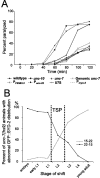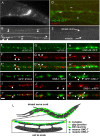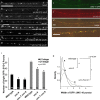Caenorhabditis elegans innexins regulate active zone differentiation
- PMID: 19386917
- PMCID: PMC6665469
- DOI: 10.1523/JNEUROSCI.0637-09.2009
Caenorhabditis elegans innexins regulate active zone differentiation
Abstract
In a genetic screen for active zone defective mutants in Caenorhabditis elegans, we isolated a loss-of-function allele of unc-7, a gene encoding an innexin/pannexin family gap junction protein. Innexin UNC-7 regulates the size and distribution of active zones at C. elegans neuromuscular junctions. Loss-of-function mutations in another innexin, UNC-9, cause similar active zone defects as unc-7 mutants. In addition to presumptive gap junction localizations, both UNC-7 and UNC-9 are also localized perisynaptically throughout development and required in presynaptic neurons to regulate active zone differentiation. Our mosaic analyses, electron microscopy, as well as expression studies suggest a novel and likely nonjunctional role of specific innexins in active zone differentiation in addition to gap junction formations.
Figures






Similar articles
-
Interactions between innexins UNC-7 and UNC-9 mediate electrical synapse specificity in the Caenorhabditis elegans locomotory nervous system.Neural Dev. 2009 May 11;4:16. doi: 10.1186/1749-8104-4-16. Neural Dev. 2009. PMID: 19432959 Free PMC article.
-
RPM-1, a Caenorhabditis elegans protein that functions in presynaptic differentiation, negatively regulates axon outgrowth by controlling SAX-3/robo and UNC-5/UNC5 activity.J Neurosci. 2008 Apr 2;28(14):3595-603. doi: 10.1523/JNEUROSCI.5536-07.2008. J Neurosci. 2008. PMID: 18385318 Free PMC article.
-
A co-operative regulation of neuronal excitability by UNC-7 innexin and NCA/NALCN leak channel.Mol Brain. 2011 Apr 13;4:16. doi: 10.1186/1756-6606-4-16. Mol Brain. 2011. PMID: 21489288 Free PMC article.
-
Innexins: members of an evolutionarily conserved family of gap-junction proteins.Biochim Biophys Acta. 2005 Jun 10;1711(2):225-45. doi: 10.1016/j.bbamem.2004.10.004. Epub 2004 Nov 17. Biochim Biophys Acta. 2005. PMID: 15921654 Review.
-
Innexins get into the gap.Bioessays. 2001 May;23(5):388-96. doi: 10.1002/bies.1057. Bioessays. 2001. PMID: 11340620 Review.
Cited by
-
CFI-1 functions unilaterally to restrict gap junction formation in C. elegans.Development. 2025 Jan 1;152(1):dev202955. doi: 10.1242/dev.202955. Epub 2025 Jan 7. Development. 2025. PMID: 39679967 Free PMC article.
-
NLR-1/CASPR Anchors F-Actin to Promote Gap Junction Formation.Dev Cell. 2020 Dec 7;55(5):574-587.e3. doi: 10.1016/j.devcel.2020.10.020. Epub 2020 Nov 24. Dev Cell. 2020. PMID: 33238150 Free PMC article.
-
Regulation of neuronal axon specification by glia-neuron gap junctions in C. elegans.Elife. 2016 Oct 21;5:e19510. doi: 10.7554/eLife.19510. Elife. 2016. PMID: 27767956 Free PMC article.
-
A hyperpolarizing neuron recruits undocked innexin hemichannels to transmit neural information in Caenorhabditis elegans.Proc Natl Acad Sci U S A. 2024 May 21;121(21):e2406565121. doi: 10.1073/pnas.2406565121. Epub 2024 May 16. Proc Natl Acad Sci U S A. 2024. PMID: 38753507 Free PMC article.
-
DOP-2 D2-Like Receptor Regulates UNC-7 Innexins to Attenuate Recurrent Sensory Motor Neurons during C. elegans Copulation.J Neurosci. 2015 Jul 8;35(27):9990-10004. doi: 10.1523/JNEUROSCI.0940-15.2015. J Neurosci. 2015. PMID: 26156999 Free PMC article.
References
-
- Barnes TM, Hekimi S. The C. elegans avermectin resistance and anesthetic response gene unc-9 encodes a member of a protein family implicated in electrical coupling of excitable cells. J Neurochem. 1997;69:2251–2260. - PubMed
-
- Bennett MV, Zukin RS. Electrical coupling and neuronal synchronization in the Mammalian brain. Neuron. 2004;41:495–511. - PubMed
Publication types
MeSH terms
Substances
Grants and funding
LinkOut - more resources
Full Text Sources
Miscellaneous
